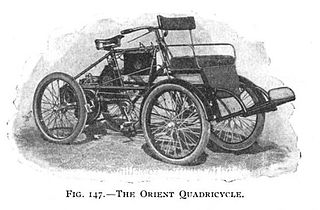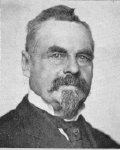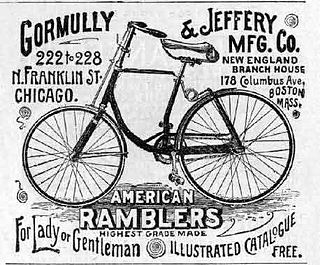
A bicycle, also called a pedal cycle, bike, push-bike or cycle, is a human-powered or motor-powered assisted, pedal-driven, single-track vehicle, having two wheels attached to a frame, one behind the other. A bicycle rider is called a cyclist, or bicyclist.
Rambler is an automobile brand name that was first used by the Thomas B. Jeffery Company between 1900 and 1914.

The penny-farthing, also known as a high wheel, high wheeler or ordinary, is an early type of bicycle. It was popular in the 1870s and 1880s, with its large front wheel providing high speeds, owing to it travelling a large distance for every rotation of the legs, and comfort, because the large wheel provided greater shock absorption.

Quadricycle refers to vehicles with four wheels.

Albert Augustus Pope was a Brevet Lieutenant-Colonel in the Union Army. He was an importer, promoter, and manufacturer of bicycles, and a manufacturer of automobiles.

Vehicles that have two wheels and require balancing by the rider date back to the early 19th century. The first means of transport making use of two wheels arranged consecutively, and thus the archetype of the bicycle, was the German draisine dating back to 1817. The term bicycle was coined in France in the 1860s, and the descriptive title "penny farthing", used to describe an "ordinary bicycle", is a 19th-century term.

A motorized bicycle is a bicycle with an attached motor or engine and transmission used either to power the vehicle unassisted, or to assist with pedalling. Since it sometimes retains both pedals and a discrete connected drive for rider-powered propulsion, the motorized bicycle is in technical terms a true bicycle, albeit a power-assisted one. Typically they are incapable of speeds above 52 km/h (32 mph), however in recent years larger motors have been built, allowing bikes to reach speeds of upwards of 72 km/h.

The Thomas B. Jeffery Company was an American automobile manufacturer in Kenosha, Wisconsin, from 1902 until 1916. The company manufactured the Rambler and Jeffery brand motorcars. It was preceded by the Gormully & Jeffery Manufacturing Company, a bicycle manufacturer. It was the predecessor company to Nash Motors, and thus one of the predecessor companies of American Motors Corporation (AMC) and later Chrysler.

Thomas Buckland Jeffery was a British emigrant to the United states who co-founded the Gormully & Jeffery company which made the Rambler bicycle. He invented the "clincher" rim which was widely used to fit tires to bicycles and early automobiles, and in 1900 established the Thomas B. Jeffery Company to make automobiles, again using Rambler branding.

Sterling Bicycle Co. was a 19th-century American bicycle company first based in Chicago, Illinois before relocating to Kenosha, Wisconsin.
Gormully & Jeffery(G&J) was an American bicycle company, founded in Chicago in 1879 by Thomas B. Jeffery and R. Philip Gormully.
Pope Manufacturing Company was founded by Albert Augustus Pope around 1876 in Boston, Massachusetts, US and incorporated in Hartford, Connecticut in 1877. Manufacturing of bicycles began in 1878 in Hartford at the Weed Sewing Machine Company factory. Pope manufactured bicycles, motorcycles, and automobiles. From 1905 to 1913, Pope gradually consolidated manufacturing to the Westfield Mass plant. The main offices remained in Hartford. It ceased automobile production in 1915 and ceased motorcycle production in 1918. The company subsequently underwent a variety of changes in form, name and product lines through the intervening years. To this day, bicycles continue to be sold under the Columbia brand.

Rambler was an American bicycle brand manufactured by the Gormully & Jeffery Manufacturing Company (G&J) in Chicago from 1878 to 1900 and subsequently by the American Bicycle Company.
CCM is a Canadian bicycle brand owned by Canadian Tire. The brand was first used by the Canada Cycle & Motor Co. Ltd, founded in Weston, Ontario in 1899. CCM dominated the Canadian bike market for much of the 20th century before becoming bankrupt in 1983. The CCM trademark was then acquired by Procycle Group, while the company's hockey assets were sold off.

The bike boom or bicycle craze is any of several specific historic periods marked by increased bicycle enthusiasm, popularity, and sales.
The history of the motorcycle begins in the second half of the 19th century. Motorcycles are descended from the "safety bicycle," a bicycle with front and rear wheels of the same size and a pedal crank mechanism to drive the rear wheel. Despite some early landmarks in its development, the motorcycle lacks a rigid pedigree that can be traced back to a single idea or machine. Instead, the idea seems to have occurred to numerous engineers and inventors around Europe at around the same time.
Cycling quickly became an activity after bicycles were introduced in the 19th century and remains popular with more than a billion people worldwide used for recreation, transportation and sport.

The following outline is provided as an overview of and topical guide to bicycles:

A wheelie bike, also called a dragster, muscle bike, high-riser, spyder bike or banana bike, is a type of stylized children's bicycle designed in the 1960s to resemble a chopper motorcycle and characterized by ape hanger handlebars, a banana seat with sissy bar, and small wheels. Notable examples include the Schwinn Sting-Ray and Krate lines and the Raleigh Chopper line. Other notable manufacturers and retailers that offered models include AMF, CCM, Columbia, Huffy, Iverson, J. C. Penney, Malvern Star, Monark, Murray, Ross, Sears, and Vindec.

Overman Wheel Company was an early bicycle manufacturing company in Chicopee Falls, Massachusetts from 1882 to 1900. It was known for bicycles of higher quality and lower weight than other bicycles of its time. Despite a nationwide bicycle craze in the late 1800s, the company was undercut by lower-priced competition, nearly went bankrupt in 1897, and never recovered from an 1899 fire. The company was sold in 1900.















